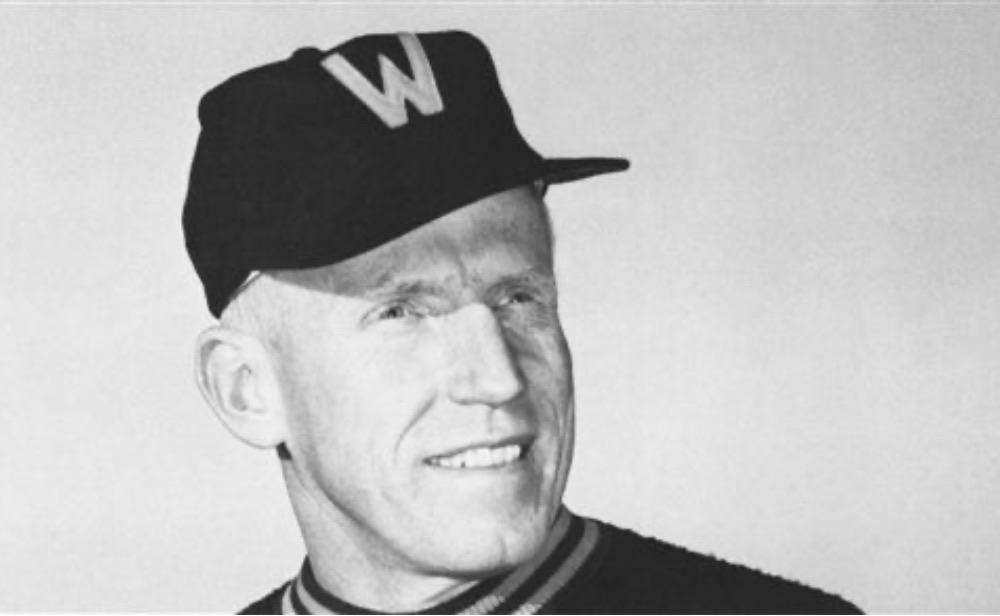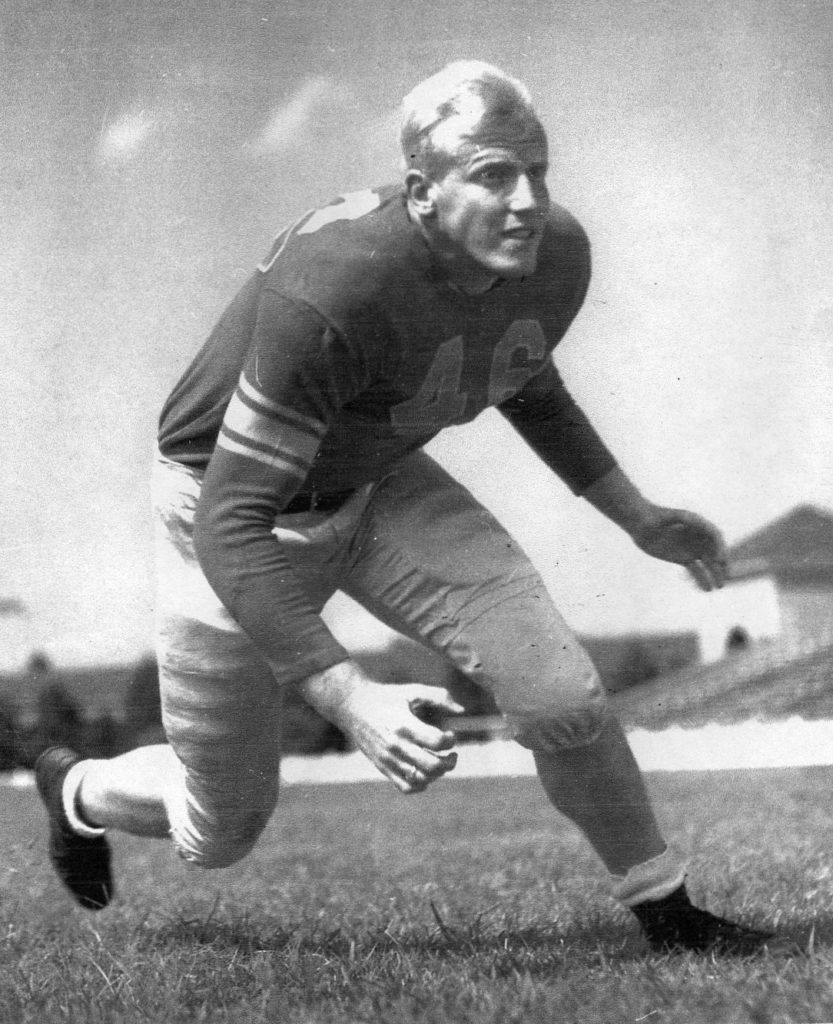
By Trey Williams
Science Hill football has been best known for skill players such as Steve Spurrier and Van Williams.
The Hilltoppers, however, have produced a long line of excellent blockers too – from Blake Austin, who started for East Tennessee State’s Southern Conference championship team in 2021, to Harry “Red” Caughron, an honorable mention All-American on William & Mary’s Southern Conference championship team in 1947.
The 6-foot-2, 215-pound Caughron was large for his era. He was a two-time honorable mention All-American for the Indians and was selected 165th overall by the Chicago Cardinals in the 1949 draft.
Caughron opted to spend his professional life compiling a Hall of Fame coaching career at Woodberry Forest in Virginia, where he went 217-56-7 in 31 seasons. Before that, he’d started a football program at Alexandria’s Hammond High School. His record there was 28-10-2.
During a conversation in 2007, Caughron stressed being more proud of developing young men than winning football games. He regretted how it’d become popular through the decades after fame and fortune helped bring a different breed of coaches to scream at their players. He said it was troubling to see men routinely lose their composure, particularly when dealing with impressionable teenagers.
Caughron preferred the way soft-spoken Tony Dungy coached. He didn’t see the need for cursing and yelling.
“I don’t believe in that (screaming and swearing),” said Caughron, who died at 88 years of age three years later. “I know some use that technique, but I would’ve got out of the business before I did that.”
Caughron played at Science Hill for Stuart “Plowboy” Farmer, who calmly made coaching appealing to Caughron.
“Plowboy taught me a lot of good fundamental football,” he said. “I probably had a better fundamental experience in high school than a lot of my William & Mary teammates. Plowboy was quiet but determined.”
Caughron started as a sophomore and junior on Science Hill’s dominant 1939-40 teams, which went 20-1-1 while outscoring opponents from Asheville to Chattanooga, 485-46.
“Those teams were really, really close and worked well together,” Caughron said. “Jack Osborne was a great running back. I really enjoyed playing with (linemen) Bob Storie, all of those guys.”
A number of players from those teams, including Osborne, Kermit Tipton and Arthur “Bud” Kelsey, spoke highly of Caughron some 70 years later, noting his size, smarts and toughness.
In 1952 the Knoxville News-Sentinel selected an 11-man squad – four backs, two ends and five linemen – from all of its All-East Tennessee teams since 1938. Caughron was on the team with five players from Knoxville, three from Dobyns-Bennett (Bobby Cifers, Darrell Crawford, Hal Miller) and one apiece from Bristol (Hal Littleford) and Elizabethton (Earl Campbell).

Caughron also lettered in basketball and track & field at Science Hill, where he was the senior class president. He was voted best all-around athlete and best all-around boy at Science Hill.
The late Billy Joe Bowman, a Science Hill Hall of Famer and baseball standout for the Tennessee Volunteers, fondly recalled Caughron shortly after his death in 2010. Bowman was eight years younger than Caughron, but was thrilled to have “Red” block for him during pickup games at Stratton Elementary School.
“Harry would let me run the ball while he blocked,” Bowman said with a chuckle. “I used to go watch him play football for Science Hill. He was something. You learn something, or you should, watching people like Harry Caughron … and all of their tenacity and dedication.”
Caughron’s dedication was put to the ultimate test following his freshman season at William & Mary. He entered World War II and endured the Battle of the Bulge and a number of other battles that 64 years didn’t make any less difficult to discuss.
Caughron began combat near Germany in October of ‘43, and was on the front from December until the end of the war.
“We found the average German family to be wonderful,” Caughron said. “(Adolf) Hitler just poisoned a lot of the right minds.”
Caughron escaped Europe essentially unscathed physically and returned to William & Mary, where he thrived for three seasons.
He helped pave the way for a 24-6-2 record and co-captained the 1948 squad that defeated Oklahoma State in the Delta Bowl. He helped the Indians earn a bid to the Dixie Bowl in Birmingham, Ala., on Jan. 1, 1949, where they lost 21-19 to Arkansas.
The Richmond Times-Dispatch covered a banquet during which Caughron was named co-captain prior to his season: “Caughron, whose jewel-like consistency is commented upon by nearly every coach whose team faces William & Mary, earned a berth in the Tribe’s forewall right from the start of the ‘46 season and last year was regarded by rival coaches and professional football scouts as one of the South’s outstanding linemen.”
There wasn’t much money being made by anyone knocking heads in pro football at the time. Caughron opted for a master’s degree while beginning his coaching career.
He coached at Woodberry Forest (Va.) from 1960-90 and became the athletic director in ‘61. Caughron was the VirginaPrep League Coach of the Year eight times and also coached track, junior varsity lacrosse and freshman basketball.
Caughron’s wife – the former Catherine Jones of 709 North Roan Street, he might tell you – missed only one game during Caughron’s coaching career and that was for jury duty. They started the Woodberry Forest Sports Camp in 1967, which accommodated 132 boys (ages 10-13) each summer. More than $400,000 was raised for the Red and Cathy Caughron Athletic Endowment as of their final year at the school, and Caughronsaid it continued to grow after his retirement.
Former players revered Caughron, describing him as humble to a fault.
Jack Edwards played three years (1958-60) for Caughron. Edwards became a doctor, Chief of the Infectious Diseases Division at Harbor/UCLA Medical Center.
“It is now 45 years later since my graduation from Hammond,” Edwards wrote in a letter to the Virgina Sports Hall of Fame in 2005. “In all my experience since then, I have never encountered a finer or more inspirational person than Coach Caughron. … Coach Caughron never ever lost his composure, despite the most provoking circumstances.”
Caughron, the son of a widow much of his childhood, credited much of his development to playing for Science Hill coaches such as Farmer. His high school experience inspired him to inspire via coaching.
“We had good teams, a great band and really good support,” Caughron said. “I really enjoyed those times (at Science Hill).”
The late Sidney Smallwood, a longtime coach and administrator at Science Hill, ran into Caughron at the VPI Relays in 1956.
“Harry said it sure was nice,” Smallwood said, “to see Hilltopper uniforms again.”



